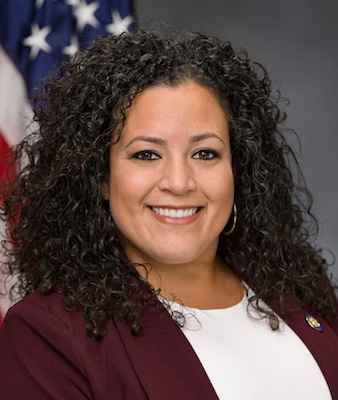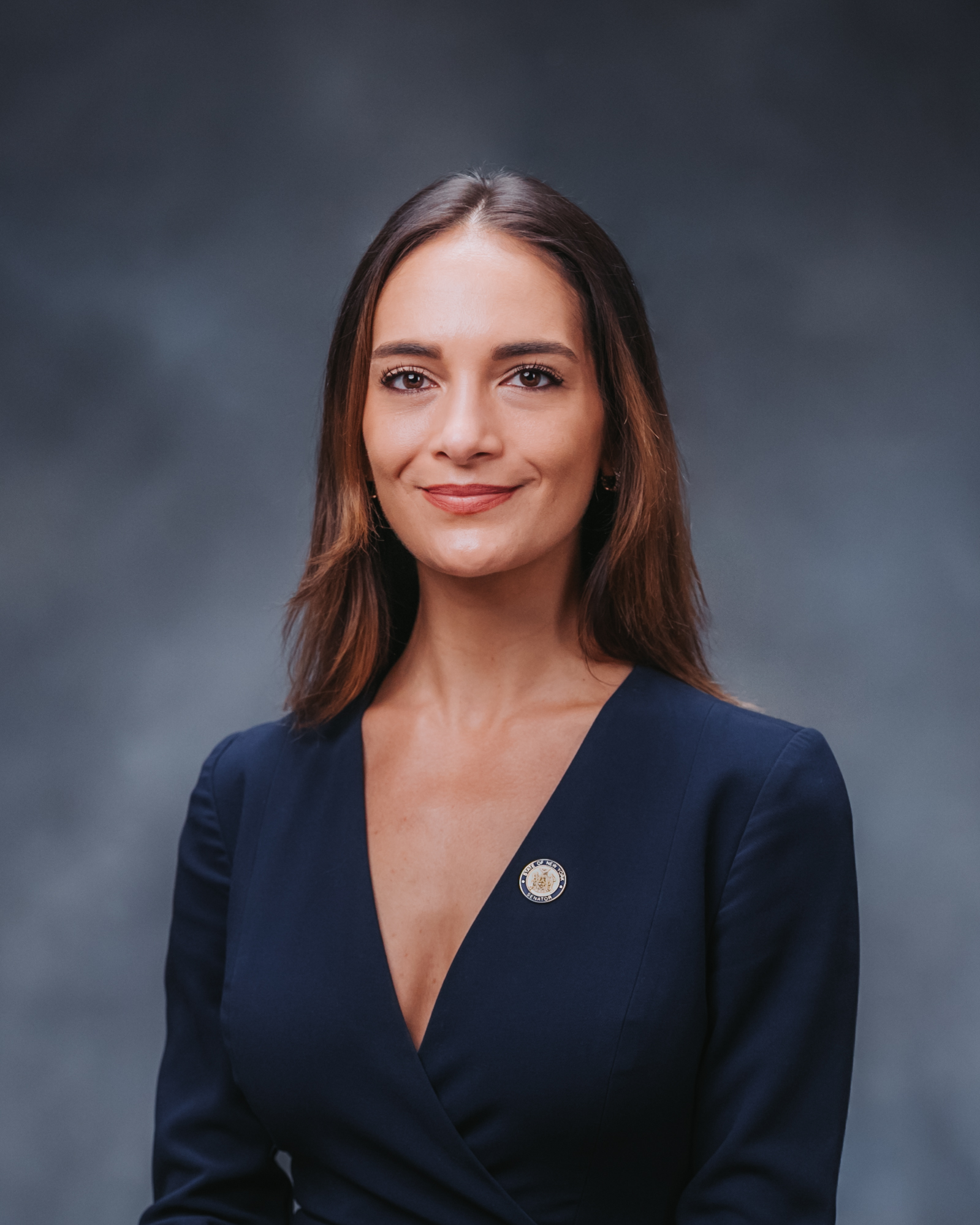| Date of Action |
Assembly Actions -
Lowercase Senate Actions - UPPERCASE |
|---|---|
| Jan 03, 2024 |
referred to commerce, economic development and small business |
| Jan 31, 2023 |
referred to commerce, economic development and small business |
Find your Senator and share your views on important issues.
Senate Bill S3389
2023-2024 Legislative Session
Relates to economic development projects involving the use of fossil fuels; relates to tax on sales of motor fuel and petroleum products; repealer
download bill text pdfSponsored By
(D, WF) 28th Senate District
Archive: Last Bill Status - In Senate Committee Commerce, Economic Development And Small Business Committee
- Introduced
-
- In Committee Assembly
- In Committee Senate
-
- On Floor Calendar Assembly
- On Floor Calendar Senate
-
- Passed Assembly
- Passed Senate
- Delivered to Governor
- Signed By Governor
Actions
co-Sponsors
(D, WF) Senate District
(D, WF) 25th Senate District
(D) 30th Senate District
(D) 34th Senate District
(D, WF) 12th Senate District
(D, WF) 59th Senate District
(D) 26th Senate District
(D, WF) 40th Senate District
(D, WF) 47th Senate District
(D, WF) 31st Senate District
(D) 27th Senate District
(D, WF) 48th Senate District
(D) 20th Senate District
(D, WF) 13th Senate District
(D, WF) 33rd Senate District
(D, WF) 18th Senate District
(D) 10th Senate District
(D) 32nd Senate District
(D, WF) 29th Senate District
(D) 11th Senate District
2023-S3389 (ACTIVE) - Details
- See Assembly Version of this Bill:
- A7949
- Current Committee:
- Senate Commerce, Economic Development And Small Business
- Law Section:
- Economic Development Law
- Laws Affected:
- Amd §§352, 355 & 433, Ec Dev L; amd §66, Pub Serv L; rpld §301-a sub (g) ¶4, sub (f) ¶3, §301-c subs (i), (j) & (l), §301-d, §301-e sub (f), §1105 sub (c) ¶3 sub¶ (xi), §1115 sub (a) ¶9, amd Tax L, generally; amd §3102-e, Pub Auth L
- Versions Introduced in Other Legislative Sessions:
-
2021-2022:
S7438, A8483
2025-2026: S3606, A3675
2023-S3389 (ACTIVE) - Summary
Limits the use of fossil fuels in the research or production of energy for purposes of the excelsior jobs program; prohibits businesses engaged in the production, transmission, distribution, transportation or storage of fossil fuels from participation in the START-UP NY program; eliminates property that directly produces, transmits, distributes, transports or stores fossil fuels from qualifying tangible property for purposes of the investment tax credit and the Brownfield redevelopment tax credit; relates to tax on sales of motor fuel and petroleum products and makes conforming changes
2023-S3389 (ACTIVE) - Sponsor Memo
BILL NUMBER: S3389
SPONSOR: KRUEGER
TITLE OF BILL:
An act to amend the economic development law and the public service law,
in relation to limiting the use of fossil fuels in the research or
production of energy for purposes of the excelsior jobs program; to
amend the economic development law, in relation to prohibiting busi-
nesses engaged in the production, transmission, distribution, transpor-
tation or storage of fossil fuels from participation in the START-UP NY
program; to amend the tax law, in relation to eliminating property that
directly produces, transmits, distributes, transports or stores fossil
fuels from qualifying tangible property for purposes of the investment
tax credit and the Brownfield redevelopment tax credit; to amend the tax
law, in relation to tax on sales of motor fuel and petroleum products
and to make conforming changes; to amend the tax law, in relation to the
definition of qualified rehabilitation expenditures for purposes of the
tax credit for rehabilitation of historic properties; to amend the
public authorities law, in relation to the definition of a qualified
emerging technology company; to amend the tax law, in relation to the
definition of manufacturer for purposes of the calculation of special
tax benefits for qualified New York manufacturers; to repeal paragraph 3
of subdivision (f) and paragraph 4 of subdivision (g) of section 301-a
of the tax law relating to manufacturing gallonage for purposes of the imposition of certain taxes; to repeal subdivisions (i), (j), and (l) of section 301-c of the tax law relating to reimbursement; to repeal section 301-d of the tax law relating to a utility credit or reimbursement; to repeal subdivision (f) of section 301-e of the tax law relating to an aviation fuel business which services four or more cities; to repeal subparagraph (xi) of paragraph 3 of subdivision (c) of section 1105 of the tax law relating to services rendered with respect to certain property; and to repeal paragraph 9 of subdivision (a) of section 1115 of the tax law relating to fuel sold to an airline for use in its airplanes PURPOSE: The purpose of the bill is to repeal certain exemptions from sales and use tax and petroleum business tax, as well as tax incentives for a variety of economic development programs, that encourage the use of fossil fuels. SUMMARY OF SPECIFIC PROVISIONS: Section 1: Names the bill. Section 2-4: Removes incidental fossil fuel incentives within the Excelsior Jobs Program. Section 5: Adds fossil fuel businesses to the list of businesses prohib- ited from participating in the START-UP NY Program. Section 6: Removes incidental fossil fuel incentives from the Investment Tax Credit. Section 7: Conforming technical change. Section 8: Repeals an exemption from Petroleum Business Tax ,for manu- facturing using non-highway diesel fuel and residual petroleum product. Section 9: Repeals exemptions from Petroleum Business Tax for kerosene, kero-jet fuel, residual petroleum product (bunker fuel), liquefied petroleum gases, and non-highway diesel motor fuel used for nonresiden- tial heating purposes. Section 10: Repeals an exemption from Petroleum Business Tax for sales to the government of New York state. Section 11 and 11-a: Repeals a reimbursement for Petroleum Business Tax paid for non-highway diesel motor fuel used for non-residential heating purposes, and for motor fuel and diesel motor fuel sold to the govern- ment of New York state. Section 12: Repeals a reimbursement for Petroleum Business Tax paid for commercial gallonage, manufacturing gallonage, and gallonage used in mining and extracting. Section 13: Conforming technical change. Section 14: Repeals a credit or reimbursement for Petroleum Business Tax paid for residual petroleum product and non-highway diesel motor fuel used by an electric corporation. Section 15: Repeals an exemption from Petroleum Business Tax for certain airlines. Section 16: Repeals an exemption from Petroleum Business Tax for commer- cial gallonage. Section 17: Removes incidental fossil fuel incentives from the Invest- ment Tax Credit. Section 18: Removes incidental fossil fuel incentives from the Brown- field Redevelopment Tax Credit. Section 19: Removes incidental fossil fuel incentives from the Rehabili- tation of Historic Properties Tax Credit. Section 20: Repeals an exemption from Sales and Use Tax for oil and gas production services. Section 21: Unrelated cleanup. Section 22: Repeals an exemption from Sales and Use Tax for airline fuel. Section 23: Repeals an exemption from Sales and Use Tax for gas used in research and development. Section 24: Repeals an exemption from Sales and Use Tax for fuel and gas used in production of tangible personal property. Section 25 and 25-a: Conforming technical changes. Section 26: Unre- lated cleanup. Section 27: Repeals an exemption from Sales and Use Tax for gas used to maintain gas distribution infrastructure. Section 28: Conforming technical changes. Section 29: Conforming techni- cal change. Section 30: Removes incidental fossil fuel incentives from the Rehabili- tation of Historic Properties Tax Credit. Section 31: Excludes fossil fuel companies from the definition of quali- fied emerging technology companies and qualified emerging technology investments. Section 32 and 33: Excludes fossil fuel production, transmission, distribution, transportation, and storage from eligibility for special tax benefits for qualified New York manufacturers. Section 34: Effective date. JUSTIFICATION: New York State spends over $1.5 billion every year on fossil fuel related tax expenditures, as well as an unknown sum on economic develop- ment tax expenditures that incidentally support the use of fossil fuels, distorting the market and subsidizing the emission of greenhouse gases that drive the climate crisis. Some of these tax expenditures may serve a compelling public interest such as offering heating assistance to low-income New Yorkers. However, a significant proportion cf the spend- ing serves to prop-up outdated industries or reward energy inefficien- cies leading to a double cost to taxpayers - once for the direct tax expenditure and again for the environmental damage resulting from the continued burning of fossil fuels. This bill begins the process of aligning New York state tax policy by repealing some of the more egregious fossil fuel related tax expendi- tures and ensuring economic development tax expenditures are not contributing to increased fossil fuel use. Repeal of these expenditures would save the state at least roughly $336 million annually, based on information available in the FY 2022 Annual Report on New York State Tax Expenditures, produced by the Division of Budget. LEGISLATIVE HISTORY: 2021-22: S.7438/A.8483 Referred to Economic Dev. Committee FISCAL IMPACT ON THE STATE: Potential savings of over $300 million annually. EFFECTIVE DATE: This act shall take effect immediately and shall apply to all tax years commencing on or after the first of January next succeeding the date on which it shall have become a law.
2023-S3389 (ACTIVE) - Bill Text download pdf
S T A T E O F N E W Y O R K
________________________________________________________________________
3389
2023-2024 Regular Sessions
I N S E N A T E
January 31, 2023
___________
Introduced by Sens. KRUEGER, CLEARE, GOUNARDES, HOYLMAN-SIGAL, JACKSON,
MAY, MYRIE, RAMOS, RIVERA, SALAZAR, STAVISKY -- read twice and ordered
printed, and when printed to be committed to the Committee on
Commerce, Economic Development and Small Business
AN ACT to amend the economic development law and the public service law,
in relation to limiting the use of fossil fuels in the research or
production of energy for purposes of the excelsior jobs program; to
amend the economic development law, in relation to prohibiting busi-
nesses engaged in the production, transmission, distribution, trans-
portation or storage of fossil fuels from participation in the START-
UP NY program; to amend the tax law, in relation to eliminating
property that directly produces, transmits, distributes, transports or
stores fossil fuels from qualifying tangible property for purposes of
the investment tax credit and the Brownfield redevelopment tax credit;
to amend the tax law, in relation to tax on sales of motor fuel and
petroleum products and to make conforming changes; to amend the tax
law, in relation to the definition of qualified rehabilitation expend-
itures for purposes of the tax credit for rehabilitation of historic
properties; to amend the public authorities law, in relation to the
definition of a qualified emerging technology company; to amend the
tax law, in relation to the definition of manufacturer for purposes of
the calculation of special tax benefits for qualified New York
manufacturers; to repeal paragraph 3 of subdivision (f) and paragraph
4 of subdivision (g) of section 301-a of the tax law relating to manu-
facturing gallonage for purposes of the imposition of certain
taxes; to repeal subdivisions (i), (j), and (l) of section 301-c of
the tax law relating to reimbursement; to repeal section 301-d of
the tax law relating to a utility credit or reimbursement; to repeal
subdivision (f) of section 301-e of the tax law relating to an
aviation fuel business which services four or more cities; to repeal
subparagraph (xi) of paragraph 3 of subdivision (c) of section 1105 of
the tax law relating to services rendered with respect to certain
property; and to repeal paragraph 9 of subdivision (a) of section 1115
EXPLANATION--Matter in ITALICS (underscored) is new; matter in brackets
[ ] is old law to be omitted.
LBD08180-02-3
S. 3389 2 of the tax law relating to fuel sold to an airline for use in its airplanes THE PEOPLE OF THE STATE OF NEW YORK, REPRESENTED IN SENATE AND ASSEM- BLY, DO ENACT AS FOLLOWS: Section 1. Short title. This act shall be known and may be cited as the "Stop Climate Polluter Handouts Act". § 2. Subdivisions 17, 18, 21, and 22 of section 352 of the economic development law, subdivisions 17, 18 and 21 as amended by section 1 of part K of chapter 59 of the laws of 2017, subdivision 18 as separately amended by section 1 of part ZZ of chapter 59 of the laws of 2017, subdivision 22 as amended by chapter 572 of the laws of 2022, are amended to read as follows: 17. "Qualified investment" means an investment in tangible property (including a building or a structural component of a building) owned by a business enterprise which: (a) is depreciable pursuant to section one hundred sixty-seven of the internal revenue code; (b) has a useful life of four years or more; (c) is acquired by purchase as defined in section one hundred seven- ty-nine (d) of the internal revenue code; (d) DOES NOT DIRECTLY PRODUCE, TRANSMIT, DISTRIBUTE, TRANSPORT, OR STORE FOSSIL FUELS OR DIRECTLY UTILIZE FOSSIL FUELS FOR THE PRODUCTION OF ON-SITE ENERGY, INCLUDING THERMAL ENERGY, FOR ANY PURPOSE. FOR THE PURPOSES OF THIS ARTICLE, FOSSIL FUEL SHALL HAVE THE SAME DEFINITION AS IN SECTION 1-103 OF THE ENERGY LAW; (E) has a situs in this state; and [(e)] (F) is placed in service in the state on or after the date the certificate of eligibility is issued to the business enterprise. 18. "Regionally significant project" means (a) a manufacturer creating at least ten net new jobs in the state and making significant capital investment in the state; (b) a business creating at least ten net new jobs in agriculture in the state and making significant capital invest- ment in the state, (c) a financial services firm, distribution center, or back office operation creating at least one hundred net new jobs in the state and making significant capital investment in the state, (d) a scientific research and development firm creating at least ten net new jobs in the state, and making significant capital investment in the state, (e) a life sciences company creating at least twenty net new jobs in the state and making significant capital investment in the state or (f) an entertainment company creating or obtaining at least two hundred net new jobs in the state and making significant capital investment in the state. Other businesses creating one hundred fifty or more net new jobs in the state and making significant capital investment in the state may be considered eligible as a regionally significant project by the commissioner as well. A REGIONALLY SIGNIFICANT PROJECT SHALL NOT BE ENGAGED IN THE PRODUCTION, TRANSMISSION, DISTRIBUTION, TRANSPORTATION, STORAGE, SALE, PURCHASE, OR DELIVERY OF FOSSIL FUELS. The commissioner shall promulgate regulations pursuant to section three hundred fifty-six of this article to determine what additional criteria a business must meet to be eligible as a regionally significant project, including, but not limited to, whether a business exports a substantial portion of its products or services outside of the state or outside of a metropolitan statistical area or county within the state. S. 3389 3 21. "Research and development expenditures" mean the expenses of the business enterprise that are qualified research expenses under the federal research and development credit under section forty-one of the internal revenue code and are attributable to activities conducted in the state. If the federal research and development credit has expired, then the research and development expenditures shall be calculated as if the federal research and development credit structure and definition in effect in federal tax year two thousand nine were still in effect. RESEARCH AND DEVELOPMENT EXPENDITURES DOES NOT INCLUDE ANY EXPENSES FOR TANGIBLE PERSONAL PROPERTY THAT DIRECTLY PRODUCES, TRANSMITS, DISTRIB- UTES, TRANSPORTS, OR STORES FOSSIL FUELS OR DIRECTLY UTILIZES FOSSIL FUELS FOR THE PRODUCTION OF ON-SITE ENERGY, INCLUDING THERMAL ENERGY, FOR ANY PURPOSE. 22. "Scientific research and development" means conducting research and experimental development in the physical, engineering, and life sciences, including but not limited to agriculture, animal fiber, elec- tronics, environmental, biology, botany, biotechnology, computers, chem- istry, food, fisheries, forests, geology, health, mathematics, medicine, oceanography, pharmacy, physics, plant fiber, veterinary, and other allied subjects. For the purposes of this article, scientific research and development does not include medical or veterinary laboratory test- ing facilities, OR ANY RESEARCH THAT CONTRIBUTES TO THE PRODUCTION, TRANSMISSION, DISTRIBUTION, TRANSPORTATION, STORAGE, SALE, PURCHASE, OR DELIVERY OF FOSSIL FUELS. § 3. Subdivision 7 of section 355 of the economic development law, as amended by chapter 494 of the laws of 2022, is amended to read as follows: 7. For availability of special excelsior jobs program rates governing the provision of [gas or] electric service, see subdivision twelve-d of section sixty-six of the public service law. Such special excelsior jobs program rates may remain available to participants as defined in this article for a period of up to ten years commencing in the first taxable year that the participant receives a certificate of tax credit, or the first taxable year listed on its preliminary schedule of benefits, whichever is later. Notwithstanding any other provision of this section, such special excelsior job program rates shall remain available to a Green CHIPS project which enters into a phase two of such project for the entirety of both of its schedules of benefits. Provided however, if a participant is removed from the excelsior jobs program pursuant to this article, the excelsior jobs program rates may be denied. § 4. Subdivision 12-d of section 66 of the public service law, as added by section 8 of part G of chapter 61 of the laws of 2011, is amended to read as follows: 12-d. Notwithstanding any other provision of law, upon application of [a gas or] AN electric corporation, the commission shall authorize such corporation to charge a special excelsior jobs program rate equal to the incremental cost of providing ELECTRIC service to participants in the excelsior jobs program as defined in article seventeen of the economic development law. § 5. Subdivision 2 of section 433 of the economic development law, as added by section 1 of part A of chapter 68 of the laws of 2013, is amended to read as follows: 2. The following types of businesses are prohibited from participating in the START-UP NY program. (a) retail and wholesale businesses; (b) restaurants; S. 3389 4 (c) real estate brokers; (d) law firms; (e) medical or dental practices; (f) real estate management companies; (g) hospitality; (h) finance and financial services; (i) businesses providing personal services; (j) businesses providing business administrative or support services, unless such business has received permission from the commissioner to apply to participate in the START-UP NY program upon demonstration that the business would create no fewer than one hundred net new jobs in the tax-free NY area; (k) accounting firms; (l) businesses providing utilities; [and] (m) businesses engaged in the generation or distribution of electric- ity, the distribution of natural gas, or the production of steam associ- ated with the generation of electricity; AND (N) BUSINESSES ENGAGED IN THE PRODUCTION, TRANSMISSION, DISTRIBUTION, TRANSPORTATION, OR STORAGE OF FOSSIL FUELS AS DEFINED IN SECTION 1-103 OF THE ENERGY LAW. § 6. Subparagraph (i) of paragraph (b) of subdivision 1 of section 210-B of the tax law, as amended by section 2 of part P of chapter 59 of the laws of 2017, is amended to read as follows: (i) A credit shall be allowed under this subdivision with respect to tangible personal property and other tangible property, including build- ings and structural components of buildings, which are: depreciable pursuant to section one hundred sixty-seven of the internal revenue code, have a useful life of four years or more, are acquired by purchase as defined in section one hundred seventy-nine (d) of the internal revenue code, have a situs in this state and are (A) principally used by the taxpayer in the production of goods by manufacturing, processing, assembling, refining, mining, extracting, farming, agriculture, horti- culture, floriculture, viticulture or commercial fishing, (B) industrial waste treatment facilities or air pollution control facilities, used in the taxpayer's trade or business, (C) research and development property, or (D) principally used in the ordinary course of the taxpayer's trade or business as a broker or dealer in connection with the purchase or sale (which shall include but not be limited to the issuance, entering into, assumption, offset, assignment, termination, or transfer) of stocks, bonds or other securities as defined in section four hundred seventy-five (c)(2) of the Internal Revenue Code, or of commodities as defined in section four hundred seventy-five (e) of the Internal Revenue Code, (E) principally used in the ordinary course of the taxpayer's trade or business of providing investment advisory services for a regu- lated investment company as defined in section eight hundred fifty-one of the Internal Revenue Code, or lending, loan arrangement or loan orig- ination services to customers in connection with the purchase or sale (which shall include but not be limited to the issuance, entering into, assumption, offset, assignment, termination, or transfer) of securities as defined in section four hundred seventy-five (c)(2) of the Internal Revenue Code, (F) principally used in the ordinary course of the taxpay- er's business as an exchange registered as a national securities exchange within the meaning of sections 3(a)(1) and 6(a) of the Securi- ties Exchange Act of 1934 or a board of trade as defined in subparagraph one of paragraph (a) of section fourteen hundred ten of the not-for-pro- fit corporation law or as an entity that is wholly owned by one or more S. 3389 5 such national securities exchanges or boards of trade and that provides automation or technical services thereto, or (G) principally used as a qualified film production facility including qualified film production facilities having a situs in an empire zone designated as such pursuant to article eighteen-B of the general municipal law, where the taxpayer is providing three or more services to any qualified film production company using the facility, including such services as a studio lighting grid, lighting and grip equipment, multi-line phone service, broadband information technology access, industrial scale electrical capacity, food services, security services, and heating, ventilation and air conditioning. For purposes of clauses (D), (E) and (F) of this subpara- graph, property purchased by a taxpayer affiliated with a regulated broker, dealer, registered investment advisor, national securities exchange or board of trade, is allowed a credit under this subdivision if the property is used by its affiliated regulated broker, dealer, registered investment advisor, national securities exchange or board of trade in accordance with this subdivision. For purposes of determining if the property is principally used in qualifying uses, the uses by the taxpayer described in clauses (D) and (E) of this subparagraph may be aggregated. In addition, the uses by the taxpayer, its affiliated regu- lated broker, dealer and registered investment advisor under either or both of those clauses may be aggregated. Provided, however, a taxpayer shall not be allowed the credit provided by clauses (D), (E) and (F) of this subparagraph unless the property is first placed in service before October first, two thousand fifteen and (i) eighty percent or more of the employees performing the administrative and support functions resulting from or related to the qualifying uses of such equipment are located in this state or (ii) the average number of employees that perform the administrative and support functions resulting from or related to the qualifying uses of such equipment and are located in this state during the taxable year for which the credit is claimed is equal to or greater than ninety-five percent of the average number of employ- ees that perform these functions and are located in this state during the thirty-six months immediately preceding the year for which the cred- it is claimed, or (iii) the number of employees located in this state during the taxable year for which the credit is claimed is equal to or greater than ninety percent of the number of employees located in this state on December thirty-first, nineteen hundred ninety-eight or, if the taxpayer was not a calendar year taxpayer in nineteen hundred ninety- eight, the last day of its first taxable year ending after December thirty-first, nineteen hundred ninety-eight. If the taxpayer becomes subject to tax in this state after the taxable year beginning in nine- teen hundred ninety-eight, then the taxpayer is not required to satisfy the employment test provided in the preceding sentence of this subpara- graph for its first taxable year. For purposes of clause (iii) of this subparagraph the employment test will be based on the number of employ- ees located in this state on the last day of the first taxable year the taxpayer is subject to tax in this state. If the uses of the property must be aggregated to determine whether the property is principally used in qualifying uses, then either each affiliate using the property must satisfy this employment test or this employment test must be satisfied through the aggregation of the employees of the taxpayer, its affiliated regulated broker, dealer, and registered investment adviser using the property. For purposes of clause (A) of this subparagraph, tangible personal property and other tangible property shall not include property principally used by the taxpayer in the production or distribution of S. 3389 6 electricity, natural gas after extraction from wells, steam, or water delivered through pipes and mains. FOR PURPOSES OF THIS SUBDIVISION, TANGIBLE PERSONAL PROPERTY AND OTHER TANGIBLE PROPERTY DOES NOT INCLUDE PROPERTY THAT DIRECTLY PRODUCES, TRANSMITS, DISTRIBUTES, TRANSPORTS, OR STORES FOSSIL FUELS AS DEFINED IN SECTION 1-103 OF THE ENERGY LAW, OR DIRECTLY UTILIZES FOSSIL FUELS FOR THE PRODUCTION OF ON-SITE ENERGY, INCLUDING THERMAL ENERGY, FOR ANY PURPOSE. § 7. Subdivision (m) of section 301-a of the tax law, as added by section 20 of part K of chapter 61 of the laws of 2011, is amended to read as follows: (m) Special rate adjustment for certain vessels. Notwithstanding any provision of this section to the contrary, the use of non-highway diesel motor fuel in the engine of a vessel to propel such vessel shall be subject to tax at the motor fuel and highway diesel motor fuel rate provided for in this section, and shall be subject to the provisions of section three hundred one-j of this article, including the adjustment set forth in paragraph [four] THREE of subdivision (a) of such section three hundred one-j. A credit or refund shall be available to the extent tax paid on gallonage used to propel any such vessel exceeds the amount of tax due based on the tax rate set forth herein. Provided, however, that the commissioner shall require such documentary proof to qualify for any credit or reimbursement provided hereunder as the commissioner deems appropriate. § 8. Paragraph 3 of subdivision (f) and paragraph 4 of subdivision (g) of section 301-a of the tax law are REPEALED. § 9. Subdivisions (a) and (d) of section 301-b of the tax law, subdi- vision (a) as added by chapter 190 of the laws of 1990, paragraph 5 of subdivision (a) as amended by section 3 of part E of chapter 59 of the laws of 2012, paragraphs 6, 7 and 8 of subdivision (a) as added by section 4 of part W-1 of chapter 109 of the laws of 2006, and subdivi- sion (d) as amended by section 21 of part K of chapter 61 of the laws of 2011, are amended to read as follows: (a) Products. (1) [Kerosene sold or used by a petroleum business which is registered under article twelve-A of this chapter as a distributor of diesel motor fuel so long as (i) such product has not been blended or mixed with any other product constituting diesel motor fuel or motor fuel or a residual petroleum product and (ii) such product is not used by the petroleum business as fuel to operate a motor vehicle or sold by such petroleum business to a consumer for use as fuel to operate a motor vehicle. (2) Kero-jet fuel (i) sold by a petroleum business which is registered under article twelve-A of this chapter as a distributor of diesel motor fuel to a consumer for use exclusively as jet aircraft fuel or to a petroleum business registered under such article twelve-A as a "distrib- utor of kero-jet fuel only" where such fixed base operator is engaged solely in making or offering to make retail sales not in bulk of kero- jet fuel directly into the fuel tank of an airplane for the purpose of operating such airplane, (ii) used by a petroleum business, registered under article twelve-A of this chapter as a distributor of diesel motor fuel, exclusively as jet aircraft fuel, or (iii) sold at retail not in bulk by a petroleum business registered under article twelve-A of this chapter as a "distributor of kero-jet fuel only" where such fuel is delivered directly into the fuel tank of a jet airplane for use in the operation of such airplane. (3)] Aviation gasoline, meeting the specifications set forth in Ameri- can Standard Testing Material Specification D910 or Military Specifica- S. 3389 7 tion MIL-G-5572, which is imported or caused to be imported into this state by a petroleum business which is registered under article twelve-A of this chapter as a distributor of motor fuel or produced, refined, manufactured or compounded in this state by such a petroleum business. [(4) Residual petroleum product sold by a petroleum business regis- tered under this article as a residual petroleum product business if such product is sold by such petroleum business to a consumer for use exclusively as bunker fuel for vessels or if such product is used by such petroleum business exclusively as bunker fuel in its own vessels. (5) Liquefied petroleum gases, such as butane, ethane or propane. (6)] (2) E85 imported or caused to be imported into this state or produced, refined, manufactured or compounded in this state by a petro- leum business registered under article twelve-A of this chapter, as a distributor of motor fuel, and then sold by such petroleum business and delivered to a filling station and placed in a storage tank of such filling station for such E85 to be dispensed directly into a motor vehi- cle for use in the operation of such vehicle. [(7)] (i) Partial B20 exemption. B20 imported or caused to be imported into this state or produced, refined, manufactured or compounded in this state by a petroleum business registered under article twelve-A of this chapter, as a distributor of diesel motor fuel, and then sold by such petroleum business. (ii) Calculation of partial exemption. The amount of the partial exemption under this paragraph shall be determined by multiplying the quantity of B20 times twenty percent of the applicable taxes otherwise imposed by this article on such fuel. [(8)] (3) CNG or hydrogen. (d) Sales to consumers for heating purposes. [(1)] Total residential heating exemption. Non-highway diesel motor fuel sold by a petroleum business registered under article twelve-A of this chapter as a distrib- utor of diesel motor fuel or residual petroleum product sold by a petro- leum business registered under this article as a residual petroleum product business to the consumer exclusively for residential heating purposes only if such non-highway diesel motor fuel is delivered into a storage tank which is not equipped with a hose or other apparatus by which such fuel can be dispensed into the fuel tank of a motor vehicle and such storage tank is attached to the heating unit burning such fuel. [(2) Partial non-residential heating exemption. (A) Non-highway diesel motor fuel sold by a petroleum business registered under article twelve-A of this chapter as a distributor of diesel motor fuel or resi- dual petroleum product sold by a petroleum business registered under this article as a residual petroleum product business to the consumer exclusively for heating, other than residential heating purposes only if such non-highway diesel motor fuel is delivered into a storage tank which is not equipped with a hose or other apparatus by which such fuel can be dispensed into the fuel tank of a motor vehicle and such storage tank is attached to the heating unit burning such fuel (B) Calculation of partial exemption. The partial exemption under this paragraph shall be determined by multiplying the quantity of non-highway diesel motor fuel and residual petroleum product eligible for the exemption times the sum of the then current rate of the supplemental tax imposed by section three hundred one-j of this article and forty-six percent of the then current rate of the tax imposed by section three hundred one-a of this article, with respect to the specific non-highway diesel motor fuel or residual petroleum product rate, as the case may be.] S. 3389 8 § 10. The subdivision heading and paragraph 1 of subdivision (c) of section 301-b of the tax law, as added by chapter 190 of the laws of 1990, are amended to read as follows: Sales to [New York state and] the federal government. (1) Motor fuel imported or caused to be imported into this state or produced, refined, manufactured or compounded in this state by a petroleum business regis- tered under article twelve-A of this chapter, as a distributor of motor fuel, and then sold by such petroleum business to an organization described in paragraph [one or] two of subdivision (a) of section eleven hundred sixteen of this chapter where such motor fuel is used by such organization for its own use or consumption. § 11. The opening paragraph and subdivisions (a) and (b) of section 301-c of the tax law, the opening paragraph as amended by section 2 of part T of chapter 59 of the laws of 2022, subdivision (a) as amended by section 23 of part K of chapter 61 of the laws of 2011, and subdivision (b) as amended by chapter 330 of the laws of 1991, are amended to read as follows: A subsequent purchaser shall be eligible for reimbursement of tax with respect to the following gallonage, subsequently sold by such purchaser in accordance with subdivision (a), (b), (e), (h), [(j), (k), (n) or (o)] (I), (K) OR (L) of this section or used by such purchaser in accordance with subdivision (c), (d), (f), (g), [(i), (l), (m)] (J) or (q) of this section, which gallonage has been included in the measure of the tax imposed by this article on a petroleum business: (a) [Non-highway Diesel motor fuel used for heating purposes. (1)] Total residential heating reimbursement. Non-highway Diesel motor fuel purchased in this state and sold by such purchaser to a consumer for use exclusively for residential heating purposes but only where (i) such non-highway diesel motor fuel is delivered into a storage tank which is not equipped with a hose or other apparatus by which such non-highway Diesel motor fuel can be dispensed into the fuel tank of a motor vehicle and such storage tank is attached to the heating unit burning such non- highway Diesel motor fuel, (ii) the tax imposed pursuant to this article has been paid with respect to such non-highway diesel motor fuel and the entire amount of such tax has been absorbed by such purchaser, and (iii) such purchaser possesses documentary proof satisfactory to the commis- sioner evidencing the absorption by it of the entire amount of the tax imposed pursuant to this article. Provided, however, that the commis- sioner is authorized, in the event that the commissioner determines that it would not threaten the integrity of the administration and enforce- ment of the tax imposed by this article, to provide a reimbursement with respect to a retail sale to a consumer for residential heating purposes of less than ten gallons of non-highway diesel motor fuel provided such fuel is not dispensed into the tank of a motor vehicle. [(2) Partial non-residential heating reimbursement. (A) Non-highway Diesel motor fuel purchased in this state and sold by such purchaser to a consumer for use exclusively for heating, other than for residential heating purposes, but only where (i) such non-highway diesel motor fuel is delivered into a storage tank which is not equipped with a hose or other apparatus by which such non-highway Diesel motor fuel can be dispensed into the fuel tank of a motor vehicle and such storage tank is attached to the heating unit burning such non-highway Diesel motor fuel, (ii) the tax imposed pursuant to this article has been paid with respect to such non-highway diesel motor fuel and the entire amount of such tax has been absorbed by such purchaser, and (iii) such purchaser possesses documentary proof satisfactory to the commissioner evidencing the S. 3389 9 absorption by it of the entire amount of the tax imposed pursuant to this article. (B) Calculation of partial reimbursement. Notwithstanding any other provision of this article, the amount of the reimbursement under this paragraph shall be determined by multiplying the quantity of non-highway diesel motor fuel eligible for the reimbursement times the sum of the then current rate of the supplemental tax imposed by section three hundred one-j of this article and forty-six percent of the then current rate of the tax imposed by section three hundred one-a of this article, with respect to the non-highway diesel motor fuel rate, as the case may be.] (b) Sales to [New York state and] the federal government. Motor fuel and diesel motor fuel purchased in this state and sold by such purchaser in this state to an organization described in paragraph [one or] two of subdivision (a) of section eleven hundred sixteen of this chapter where (i) such motor fuel or diesel motor fuel is for such organization's own use or consumption, (ii) the tax imposed pursuant to this article has been paid with respect to such motor fuel or diesel motor fuel and the entire amount of such tax has been absorbed by such purchaser and, (iii) such purchaser possesses documentary proof satisfactory to the commis- sioner of taxation and finance evidencing the absorption by it of the entire amount of the tax imposed pursuant to this article. Provided, however, that the commissioner [of taxation and finance] shall require such documentary proof to qualify for any reimbursement of tax provided by this section as the commissioner deems appropriate, including the expansion of any certification required pursuant to section two hundred eighty-five-a or two hundred eighty-five-b of this chapter to cover the taxes imposed pursuant to this article. § 11-a. The opening paragraph of section 301-c of the tax law, as amended by section 3 of part T of chapter 59 of the laws of 2022, is amended to read as follows: A subsequent purchaser shall be eligible for reimbursement of tax with respect to the following gallonage, subsequently sold by such purchaser in accordance with subdivision (a), (b), (e), (h), [(j)] or [(k)] (I) of this section or used by such purchaser in accordance with subdivision (c), (d), (f), (g), [(i), (l), (m)] (J) or (q) of this section, which gallonage has been included in the measure of the tax imposed by this article on a petroleum business: § 12. Subdivisions (i), (j) and (l) of section 301-c of the tax law are REPEALED. § 13. Subdivisions (k), (m), (n), (o) and (p) of section 301-c of the tax law are relettered subdivisions (i), (j), (k), (l) and (m). § 14. Section 301-d of the tax law is REPEALED. § 15. Subdivision (f) of section 301-e of the tax law is REPEALED. § 16. Subdivision (a) of section 301-j of the tax law, as amended by chapter 309 of the laws of 1996, paragraphs 1, 2, 3 and 4 as amended by section 29 of part K of chapter 61 of the laws of 2011, is amended to read as follows: (a) Imposition of tax. (1) In addition to the taxes imposed by sections three hundred one-a and three hundred one-e of this article, there is hereby imposed upon every petroleum business subject to tax imposed under section three hundred one-a of this article and every aviation fuel business subject to the aviation gasoline component of the tax imposed under section three hundred one-e of this article, a supple- mental monthly tax for each or any part of a taxable month at a rate of six and eight-tenths cents per gallon with respect to the products S. 3389 10 included in each component of the taxes imposed by such section three hundred one-a and the aviation gasoline component of the tax imposed by such section three hundred one-e of this article. (2) [Provided, however, "commercial gallonage," as such term is defined in subdivision (k) of section three hundred of this article, shall be exempt from the measure of the tax imposed under this section. (3)] Provided, further, "railroad diesel," as such term is defined in subdivision (l) of section three hundred of this article, shall be exempt from the measure of the tax imposed under this section. [(4)] (3) Provided, further, a separate per gallon rate shall apply with respect to highway diesel motor fuel. Such rate shall be determined by taking the adjusted rate per gallon of tax imposed under paragraph one of this subdivision as adjusted in accordance with paragraph [five] FOUR of this subdivision and subtracting therefrom one and three-quar- ters cents. Commencing January first, two thousand twelve, and each January thereafter, the per gallon rate applicable to highway diesel motor fuel shall be the adjusted rate under paragraph one of this subdi- vision as adjusted in accordance with paragraph [five] FOUR of this subdivision which commences on such date minus one and three-quarters cents. The resulting rate under this paragraph shall be expressed in hundredths of a cent. [(5)] (4) Except as herein provided, the tax imposed under this section shall be calculated in the same respective manner as the taxes imposed by section three hundred one-a and section three hundred one-e of this article. Except [for section three hundred one-d and except] as otherwise provided in this section, all the provisions of this article applicable to the taxes imposed by sections three hundred one-a and three hundred one-e of this article, shall apply with respect to the supplemental tax imposed by this section to the same extent as if it were respectively imposed by such sections. § 17. Subparagraph (A) of paragraph 2 of subsection (a) of section 606 of the tax law, as amended by section 3 of part P of chapter 59 of the laws of 2017, is amended to read as follows: (A) A credit shall be allowed under this subsection with respect to tangible personal property and other tangible property, including build- ings and structural components of buildings, which are: depreciable pursuant to section one hundred sixty-seven of the internal revenue code, have a useful life of four years or more, are acquired by purchase as defined in section one hundred seventy-nine (d) of the internal revenue code, have a situs in this state and are (i) principally used by the taxpayer in the production of goods by manufacturing, processing, assembling, refining, mining, extracting, farming, agriculture, horti- culture, floriculture, viticulture or commercial fishing, (ii) indus- trial waste treatment facilities or air pollution control facilities, used in the taxpayer's trade or business, (iii) research and development property, (iv) principally used in the ordinary course of the taxpayer's trade or business as a broker or dealer in connection with the purchase or sale (which shall include but not be limited to the issuance, enter- ing into, assumption, offset, assignment, termination, or transfer) of stocks, bonds or other securities as defined in section four hundred seventy-five (c)(2) of the Internal Revenue Code, or of commodities as defined in section 475(e) of the Internal Revenue Code, (v) principally used in the ordinary course of the taxpayer's trade or business of providing investment advisory services for a regulated investment compa- ny as defined in section eight hundred fifty-one of the Internal Revenue Code, or lending, loan arrangement or loan origination services to S. 3389 11 customers in connection with the purchase or sale (which shall include but not be limited to the issuance, entering into, assumption, offset, assignment, termination, or transfer) of securities as defined in section four hundred seventy-five (c)(2) of the Internal Revenue Code, or (vi) principally used as a qualified film production facility includ- ing qualified film production facilities having a situs in an empire zone designated as such pursuant to article eighteen-B of the general municipal law, where the taxpayer is providing three or more services to any qualified film production company using the facility, including such services as a studio lighting grid, lighting and grip equipment, multi- line phone service, broadband information technology access, industrial scale electrical capacity, food services, security services, and heat- ing, ventilation and air conditioning. For purposes of clauses (iv) and (v) of this subparagraph, property purchased by a taxpayer affiliated with a regulated broker, dealer, or registered investment adviser is allowed a credit under this subsection if the property is used by its affiliated regulated broker, dealer or registered investment adviser in accordance with this subsection. For purposes of determining if the property is principally used in qualifying uses, the uses by the taxpay- er described in clauses (iv) and (v) of this subparagraph may be aggre- gated. In addition, the uses by the taxpayer, its affiliated regulated broker, dealer and registered investment adviser under either or both of those clauses may be aggregated. Provided, however, a taxpayer shall not be allowed the credit provided by clauses (iv) and (v) of this subpara- graph unless (I) eighty percent or more of the employees performing the administrative and support functions resulting from or related to the qualifying uses of such equipment are located in this state, or (II) the average number of employees that perform the administrative and support functions resulting from or related to the qualifying uses of such equipment and are located in this state during the taxable year for which the credit is claimed is equal to or greater than ninety-five percent of the average number of employees that perform these functions and are located in this state during the thirty-six months immediately preceding the year for which the credit is claimed, or (III) the number of employees located in this state during the taxable year for which the credit is claimed is equal to or greater than ninety percent of the number of employees located in this state on December thirty-first, nineteen hundred ninety-eight or, if the taxpayer was not a calendar year taxpayer in nineteen hundred ninety-eight, the last day of its first taxable year ending after December thirty-first, nineteen hundred ninety-eight. If the taxpayer becomes subject to tax in this state after the taxable year beginning in nineteen hundred ninety-eight, then the taxpayer is not required to satisfy the employment test provided in the preceding sentence of this subparagraph for its first taxable year. For the purposes of clause (III) of this subparagraph the employment test will be based on the number of employees located in this state on the last day of the first taxable year the taxpayer is subject to tax in this state. If the uses of the property must be aggregated to determine whether the property is principally used in qualifying uses, then either each affiliate using the property must satisfy this employment test or this employment test must be satisfied through the aggregation of the employees of the taxpayer, its affiliated regulated broker, dealer, and registered investment adviser using the property. For purposes of clause (i) of this subparagraph, tangible personal property and other tangible property shall not include property principally used by the taxpayer in the production or distribution of electricity, natural gas after S. 3389 12 extraction from wells, steam, or water delivered through pipes and mains. FOR PURPOSES OF THIS SUBSECTION, TANGIBLE PERSONAL PROPERTY AND OTHER TANGIBLE PROPERTY DOES NOT INCLUDE PROPERTY THAT DIRECTLY PRODUC- ES, TRANSMITS, DISTRIBUTES, TRANSPORTS, OR STORES FOSSIL FUELS AS DEFINED IN SECTION 1-103 OF THE ENERGY LAW, OR DIRECTLY UTILIZES FOSSIL FUELS FOR THE PRODUCTION OF ON-SITE ENERGY, INCLUDING THERMAL ENERGY, FOR ANY PURPOSE. § 18. Paragraph 3 of subdivision (b) of section 21 of the tax law, as amended by chapter 420 of the laws of 2006, clause (i) of subparagraph (B) as amended by section 22 of part BB of chapter 56 of the laws of 2015, is amended to read as follows: (3) Qualified tangible property. "Qualified tangible property" is property described in either subparagraph (A) or (B) AND SUBPARAGRAPH (C) of this paragraph which: (A) (i) is depreciable pursuant to section one hundred sixty-seven of the internal revenue code, (ii) has a useful life of four years or more, (iii) has been acquired by purchase as defined in section one hundred seventy-nine (d) of the internal revenue code, (iv) has a situs on a qualified site in this state, and (v) is principally used by the taxpayer for industrial, commercial, recreational or environmental conservation purposes (including the commercial development of residential housing); or (B) (i) is, or when occupied becomes, part of a dwelling whose primary ownership structure is covered under either article nine-B of the real property law or meets the requirements of section 216 (b)(1) of the Internal Revenue Code or is part of an affordable housing project as defined in subdivision twenty-nine of section 27-1405 of the environ- mental conservation law, where units are sold as single family homes or multiple family dwellings; (ii) has been acquired by purchase (as defined in section one hundred seventy-nine (d) of the Internal Revenue Code); (iii) has a situs on a qualified site in this state; and (iv) for purposes of this subparagraph only, and notwithstanding any other section of law to the contrary, property qualifying under this subparagraph shall be deemed to be qualified tangible property for the purposes of paragraph one of subdivision (d) of this section; and in addition, for the purposes of this subdivision only, property qualifying under this subparagraph shall be deemed to have been placed in service for the purposes of paragraph three of subdivision (a) of this section when a certificate of occupancy is issued for such property; AND (C) DOES NOT DIRECTLY PRODUCE, TRANSMIT, DISTRIBUTE, TRANSPORT, OR STORE FOSSIL FUELS AS DEFINED IN SECTION 1-103 OF THE ENERGY LAW, OR DIRECTLY UTILIZE FOSSIL FUELS FOR THE PRODUCTION OF ON-SITE ENERGY, INCLUDING THERMAL ENERGY, FOR ANY PURPOSE. § 19. Subdivision 26 of section 210-B of the tax law is amended by adding a new paragraph (g) to read as follows: (G) FOR PURPOSES OF THIS SUBDIVISION, "QUALIFIED REHABILITATION EXPENDITURES" DOES NOT INCLUDE EXPENDITURES FOR PROPERTY THAT DIRECTLY PRODUCES, TRANSMITS, DISTRIBUTES, TRANSPORTS, OR STORES FOSSIL FUELS AS DEFINED IN SECTION 1-103 OF THE ENERGY LAW, OR DIRECTLY UTILIZES FOSSIL FUELS FOR THE PRODUCTION OF ON-SITE ENERGY, INCLUDING THERMAL ENERGY, FOR ANY PURPOSE. § 20. Subparagraphs (ix) and (x) of paragraph 3 and paragraph 5 of subdivision (c) of section 1105 of the tax law, subparagraph (ix) of paragraph 3 as added by chapter 395 of the laws of 1998, subparagraph S. 3389 13 (x) of paragraph 3 as added by section 1 of part FF of chapter 407 of the laws of 1999, and paragraph 5 as amended by chapter 321 of the laws of 2005, are amended to read as follows: (ix) [such services rendered with respect to tangible property used or consumed directly and predominantly in the production for sale of gas or oil by manufacturing, processing, generating, assembling, refining, mining, or extracting. (x)] such services rendered with respect to property described in paragraph twelve-a of subdivision (a) of section eleven hundred fifteen of this article. (5) Maintaining, servicing or repairing real property, property or land, as such terms are defined in the real property tax law, whether the services are performed in or outside of a building, as distinguished from adding to or improving such real property, property or land, by a capital improvement as such term capital improvement is defined in para- graph nine of subdivision (b) of section eleven hundred one of this article, but excluding (i) services rendered by an individual who is not in a regular trade or business offering his services to the public, (ii) [services rendered directly with respect to real property, property or land used or consumed directly and predominantly in the production for sale of gas or oil by manufacturing, processing, generating, assembling, refining, mining, or extracting, (iii)] services rendered with respect to real property, property or land used or consumed predominantly either in the production of tangible personal property, for sale, by farming or in a commercial horse boarding operation, or in both and [(iv)] (III) services of removal of waste material from a facility regulated as a transfer station or construction and demolition debris processing facil- ity by the department of environmental conservation, provided that the waste material to be removed was not generated by the facility. § 21. Subparagraph (xi) of paragraph 3 of subdivision (c) of section 1105 of the tax law is REPEALED. § 22. Paragraph 9 of subdivision (a) of section 1115 of the tax law is REPEALED. § 23. Paragraph (ii) of subdivision (b) of section 1115 of the tax law, as amended by section 30 of part Y of chapter 63 of the laws of 2000, is amended to read as follows: (ii) [Gas, electricity] ELECTRICITY, refrigeration and steam, and [gas,] electric, refrigeration and steam service of whatever nature for use or consumption directly and exclusively in research and development in the experimental or laboratory sense shall be exempt from the tax imposed under subdivision (b) of section eleven hundred five and the compensating use tax imposed under section eleven hundred ten of this article. Such research and development shall not be deemed to include the ordinary testing or inspection of materials or products for quality control, efficiency surveys, management studies, consumer surveys, advertising, promotions or research in connection with literary, histor- ical or similar projects. § 24. Paragraph 1 of subdivision (c) of section 1115 of the tax law, as amended by section 7 of part B of chapter 63 of the laws of 2000, is amended to read as follows: (1) [Fuel, gas, electricity] ELECTRICITY, refrigeration and steam, and [gas,] electric, refrigeration and steam service of whatever nature for use or consumption directly and exclusively in the production of tangi- ble personal property, [gas,] electricity, refrigeration or steam, for sale, by manufacturing, processing, assembling, generating, refining, mining or extracting shall be exempt from the taxes imposed under subdi- S. 3389 14 visions (a) and (b) of section eleven hundred five and the compensating use tax imposed under section eleven hundred ten of this article. § 25. Subdivision (j) of section 1115 of the tax law, as amended by section 41 of part K of chapter 61 of the laws of 2011, is amended to read as follows: (j) The exemptions provided in this section shall not apply to the tax required to be prepaid pursuant to the provisions of section eleven hundred two of this article nor to the taxes imposed by sections eleven hundred five and eleven hundred ten of this article with respect to receipts from sales and uses of motor fuel or diesel motor fuel,[ except that the exemptions provided in paragraphs nine and forty-two of subdi- vision (a) of this section shall apply to the tax required to be prepaid pursuant to the provisions of section eleven hundred two of this article and to the taxes imposed by sections eleven hundred five and eleven hundred ten of this article with respect to sales and uses of kero-jet fuel,] CNG, hydrogen and E85, provided, however, the exemption allowed for E85 shall be subject to the additional requirements provided in section eleven hundred two of this article with respect to E85. The exemption provided in subdivision (c) of this section shall apply to sales and uses of non-highway diesel motor fuel but only if all of such fuel is consumed other than on the public highways of this state. The exemption provided in subdivision (c) of this section shall apply to sales and uses of non-highway diesel motor fuel for use or consumption either in the production for sale of tangible personal property by farm- ing or in a commercial horse boarding operation, or in both but only if all of such fuel is consumed other than on the public highways of this state (except for the use of the public highways to reach adjacent farm- lands or adjacent lands used in a commercial horse boarding operation, or both). § 25-a. Subdivision (j) of section 1115 of the tax law, as amended by section 41-a of part K of chapter 61 of the laws of 2011, is amended to read as follows: (j) The exemptions provided in this section shall not apply to the tax required to be prepaid pursuant to the provisions of section eleven hundred two of this article nor to the taxes imposed by sections eleven hundred five and eleven hundred ten of this article with respect to receipts from sales and uses of motor fuel or diesel motor fuel[, except that the exemption provided in paragraph nine of subdivision (a) of this section shall apply to the tax required to be prepaid pursuant to the provisions of section eleven hundred two of this article and to the taxes imposed by sections eleven hundred five and eleven hundred ten of this article with respect to sales and uses of kero-jet fuel]. The exemption provided in subdivision (c) of this section shall apply to sales and uses of non-highway diesel motor fuel but only if all of such fuel is consumed other than on the public highways of this state. The exemption provided in subdivision (c) of this section shall apply to sales and uses of non-highway diesel motor fuel for use or consumption either in the production for sale of tangible personal property by farm- ing or in a commercial horse boarding operation, or in both but only if all of such fuel is consumed other than on the public highways of this state (except for the use of the public highways to reach adjacent farm- lands or adjacent lands used in a commercial horse boarding operation, or both). § 26. Subdivision (s) of section 1115 of the tax law, as added by chapter 201 of the laws of 1995, is relettered subdivision (p). S. 3389 15 § 27. Subdivision (w) of section 1115 of the tax law, as added by section 32 of part Y of chapter 63 of the laws of 2000, is amended to read as follows: (w) Receipts from the sale of [gas or] electricity or [gas or] elec- tric service of whatever nature and consideration given or contracted to be given for, or for the use of, [gas or] electricity or [gas or] elec- tric service of whatever nature purchased for use or consumption direct- ly and exclusively to provide [gas or] electric service of whatever nature consisting of operating [a gas pipeline or gas distribution line or] an electric transmission or distribution line [and ensuring the necessary working pressure in an underground gas storage facility] shall be exempt from sales and compensating use taxes imposed by this article. Such exempt [gas or] electricity or [gas or] electric service of whatev- er nature shall include, but shall not be limited to, such [gas or] electricity or [gas or] electric service of whatever nature used or consumed directly and exclusively to (1) [ensure necessary working pres- sure in a gas pipeline used to transport, transmit or distribute gas, (2) operate compressors used to transport, transmit or distribute gas through such a gas pipeline or distribution line or used to ensure necessary working pressure in such a storage facility, (3) operate heat- ers to prevent gas in such a pipeline or distribution line from freez- ing, (4) operate equipment which removes impurities and moisture from gas in such a pipeline or distribution line, (5)] operate substations and equipment related to electric transmission and distribution lines such as transformers, capacitors, meters, switches, communication devices and heating and cooling equipment, and [(6)] (2) ensure the reliability of electricity or electric service transmitted or distrib- uted through such lines, for example, by operating reserve capacity machinery and equipment. § 28. Subdivision (k) of section 300 of the tax law, as amended by section 17 of part K of chapter 61 of the laws of 2011, is amended to read as follows: (k) "Commercial gallonage" means gallonage (1) which is non-highway diesel motor fuel or residual petroleum product, (2) [which is included in the full measure of the non-highway diesel motor fuel component or the residual petroleum product component of the tax imposed under section three hundred one-a of this article, (3)] which does not (and will not) qualify (A) [for the utility credit or reimbursement provided for in section three hundred one-d of this article, (B)] as "manufactur- ing gallonage", as such term is defined in subdivision (m) of this section, [(C)] OR (B) for the not-for-profit organization exemption provided for in subdivision (h) of section three hundred one-b of this article, [or (D) for the heating exemption provided for in paragraph two of subdivision (d) of section three hundred one-b of this article or the heating reimbursement provided for in paragraph two of subdivision (a) of section three hundred one-c of this article,] and [(4)] (3) which will not be used nor has been used in the fuel tank connecting with the engine of a vessel. No gallonage shall qualify as "commercial gallonage" where such gallonage is eligible for the [(i) utility credit or reimbursement under such section three hundred one-d of this article, (ii) "manufacturing exemption" under paragraph three of subdivision (f) of section three hundred one-a of this article, (iii)] not-for-profit organization exemption under subdivision (h) of section three hundred one-b of this article[, or (iv) heating exemption provided for in para- graph two of subdivision (d) of section three hundred one-b of this article or the heating reimbursement provided for in paragraph two of S. 3389 16 subdivision (a) of section three hundred one-c of this article]. The commissioner shall require such documentary proof to substantiate the classification of product as "commercial gallonage" as the commissioner deems appropriate. § 29. Paragraph 1 of subdivision (f) of section 301-b of the tax law, as amended by section 21 of part K of chapter 61 of the laws of 2011, is amended to read as follows: (1) Residual petroleum product and non-highway diesel motor fuel sold to an electric corporation, [as described in subdivision (a) of section three hundred one-d of this article,] AS DEFINED IN SUBDIVISION THIRTEEN OF SECTION TWO OF THE PUBLIC SERVICE LAW, SUBJECT TO THE SUPERVISION OF THE DEPARTMENT OF PUBLIC SERVICE, which is registered with the depart- ment as a petroleum business tax direct pay permittee, and used by such electric corporation to fuel generators for the purpose of manufacturing or producing electricity where such electric corporation provides a copy of a direct pay permit authorized and issued by the commissioner, to the petroleum business making such sale. If so registered, such corporation shall be a taxpayer under this article and (i) such electric corporation shall file a return monthly and pay the applicable tax under this arti- cle, after the application of allowable credits, on all such purchases directly to the commissioner, (ii) such electric corporation shall be subject to all of the provisions of this article relating to the respon- sibilities and liabilities of taxpayers under this article with respect to such residual petroleum product and non-highway diesel motor fuel. § 30. Subdivision (y) of section 1511 of the tax law, as added by chapter 472 of the laws of 2010, is amended by adding a new paragraph 7 to read as follows: (7) FOR PURPOSES OF THIS SUBDIVISION, "QUALIFIED REHABILITATION EXPENDITURES" DOES NOT INCLUDE EXPENDITURES FOR PROPERTY THAT DIRECTLY PRODUCES, TRANSMITS, DISTRIBUTES, TRANSPORTS, OR STORES FOSSIL FUELS AS DEFINED IN SECTION 1-103 OF THE ENERGY LAW, OR DIRECTLY UTILIZES FOSSIL FUELS FOR THE PRODUCTION OF ON-SITE ENERGY, INCLUDING THERMAL ENERGY, FOR ANY PURPOSE. § 31. Paragraph (c) of subdivision 1 of section 3102-e of the public authorities law, as added by section 31 of part A of chapter 56 of the laws of 1998, is amended to read as follows: (c) "Qualified emerging technology company" shall mean a company located in New York state: (1) whose primary products or services are classified as emerging technologies and whose total annual product sales are ten million dollars or less; or (2) a company which has research and development activities in New York state and whose ratio of research and development funds to net sales equals or exceeds the average ratio for all surveyed companies classified as determined by the National Science Foundation in the most recent published results from its Survey of Industry Research and Development, or any comparable successor survey as determined by the department, and whose total annual product sales are ten million dollars or less. QUALIFIED EMERGING TECHNOLOGY COMPANY SHALL NOT INCLUDE A COMPANY ENGAGED IN THE PRODUCTION, TRANSMISSION, DISTRIB- UTION, TRANSPORTATION, OR STORAGE OF FOSSIL FUELS AS DEFINED IN SECTION 1-103 OF THE ENERGY LAW. The definition of "research and development funds" shall be the same as that used by the National Science Foundation in the aforementioned survey. § 32. Subparagraph (vi) of paragraph (a) of subdivision 1 of section 210 of the tax law, as amended by section 1 of part D of chapter 59 of the laws of 2019, is amended to read as follows: S. 3389 17 (vi) for taxable years beginning on or after January first, two thou- sand fourteen, the amount prescribed by this paragraph for a taxpayer that is a qualified New York manufacturer, shall be computed at the rate of zero percent of the taxpayer's business income base. The term "manufacturer" shall mean a taxpayer that during the taxable year is principally engaged in the production of goods by manufacturing, proc- essing, assembling, refining, mining, extracting, farming, agriculture, horticulture, floriculture, viticulture or commercial fishing. However, the generation and distribution of electricity, the distribution of natural gas, [and] the production of steam associated with the gener- ation of electricity, AND THE PRODUCTION, TRANSMISSION, DISTRIBUTION, TRANSPORTATION, OR STORAGE OF FOSSIL FUELS AS DEFINED IN SECTION 1-103 OF THE ENERGY LAW shall not be qualifying activities for a manufacturer under this subparagraph. Moreover, in the case of a combined report, the combined group shall be considered a "manufacturer" for purposes of this subparagraph only if the combined group during the taxable year is prin- cipally engaged in the activities set forth in this paragraph, or any combination thereof. A taxpayer or, in the case of a combined report, a combined group shall be "principally engaged" in activities described above if, during the taxable year, more than fifty percent of the gross receipts of the taxpayer or combined group, respectively, are derived from receipts from the sale of goods produced by such activities. In computing a combined group's gross receipts, intercorporate receipts shall be eliminated. A "qualified New York manufacturer" is a manufac- turer that has property in New York that is described in clause (A) of subparagraph (i) of paragraph (b) of subdivision one of section two hundred ten-B of this article and either (I) the adjusted basis of such property for New York state tax purposes at the close of the taxable year is at least one million dollars or (II) all of its real and personal property is located in New York. A taxpayer or, in the case of a combined report, a combined group, that does not satisfy the princi- pally engaged test may be a qualified New York manufacturer if the taxpayer or the combined group employs during the taxable year at least two thousand five hundred employees in manufacturing in New York and the taxpayer or the combined group has property in the state used in manu- facturing, the adjusted basis of which for New York state tax purposes at the close of the taxable year is at least one hundred million dollars. § 33. Subparagraph 2 of paragraph (b) of subdivision 1 of section 210 of the tax law, as amended by section 2 of part D of chapter 59 of the laws of 2019, is amended to read as follows: (2) For purposes of subparagraph one of this paragraph, the term "manufacturer" shall mean a taxpayer that during the taxable year is principally engaged in the production of goods by manufacturing, proc- essing, assembling, refining, mining, extracting, farming, agriculture, horticulture, floriculture, viticulture or commercial fishing; PROVIDED, HOWEVER, THE PRODUCTION, TRANSMISSION, DISTRIBUTION, TRANSPORTATION, OR STORAGE OF FOSSIL FUELS AS DEFINED IN SECTION 1-103 OF THE ENERGY LAW SHALL NOT BE QUALIFYING ACTIVITIES FOR A MANUFACTURER UNDER THIS SUBPAR- AGRAPH. Moreover, for purposes of computing the capital base in a combined report, the combined group shall be considered a "manufacturer" for purposes of this subparagraph only if the combined group during the taxable year is principally engaged in the activities set forth in this subparagraph, or any combination thereof. A taxpayer or, in the case of a combined report, a combined group shall be "principally engaged" in activities described above if, during the taxable year, more than fifty S. 3389 18 percent of the gross receipts of the taxpayer or combined group, respec- tively, are derived from receipts from the sale of goods produced by such activities. In computing a combined group's gross receipts, inter- corporate receipts shall be eliminated. A "qualified New York manufac- turer" is a manufacturer that has property in New York that is described in clause (A) of subparagraph (i) of paragraph (b) of subdivision one of section two hundred ten-B of this article and either (i) the adjusted basis of that property for New York state tax purposes at the close of the taxable year is at least one million dollars or (ii) all of its real and personal property is located in New York. In addition, a "qualified New York manufacturer" means a taxpayer that is defined as a qualified emerging technology company under paragraph (c) of subdivision one of section thirty-one hundred two-e of the public authorities law regard- less of the ten million dollar limitation expressed in subparagraph one of such paragraph. A taxpayer or, in the case of a combined report, a combined group, that does not satisfy the principally engaged test may be a qualified New York manufacturer if the taxpayer or the combined group employs during the taxable year at least two thousand five hundred employees in manufacturing in New York and the taxpayer or the combined group has property in the state used in manufacturing, the adjusted basis of which for New York state tax purposes at the close of the taxa- ble year is at least one hundred million dollars. § 34. This act shall take effect immediately and shall apply to taxa- ble years commencing on or after the first of January next succeeding the date on which it shall have become a law; provided, however, that: (a) the amendments to paragraphs 6, 7 and 8 of subdivision (a) of section 301-b made by section nine of this act shall not affect the repeal of such paragraphs and shall be deemed repealed therewith; (b) the amendments to the opening paragraph of section 301-c of the tax law made by section eleven of this act shall be subject to the expi- ration and reversion of such paragraph pursuant to section 19 of part W-1 of chapter 109 of the laws of 2006, as amended, when upon such date the provisions of section eleven-a of this act shall take effect; (c) the amendments to subdivisions (k) and (l) of section 301-c of the tax law made by section thirteen of this act shall not affect the repeal of such subdivisions and shall be deemed repealed therewith; and (d) the amendments to subdivision (j) of section 1115 of the tax law made by section twenty-five of this act shall be subject to the expira- tion and reversion of such subdivision pursuant to section 19 of part W-1 of chapter 109 of the laws of 2006, as amended, when upon such date the provisions of section twenty-five-a of this act shall take effect.
Comments
Open Legislation is a forum for New York State legislation. All comments are subject to review and community moderation is encouraged.
Comments deemed off-topic, commercial, campaign-related, self-promotional; or that contain profanity, hate or toxic speech; or that link to sites outside of the nysenate.gov domain are not permitted, and will not be published. Attempts to intimidate and silence contributors or deliberately deceive the public, including excessive or extraneous posting/posts, or coordinated activity, are prohibited and may result in the temporary or permanent banning of the user. Comment moderation is generally performed Monday through Friday. By contributing or voting you agree to the Terms of Participation and verify you are over 13.
Create an account. An account allows you to sign petitions with a single click, officially support or oppose key legislation, and follow issues, committees, and bills that matter to you. When you create an account, you agree to this platform's terms of participation.




















